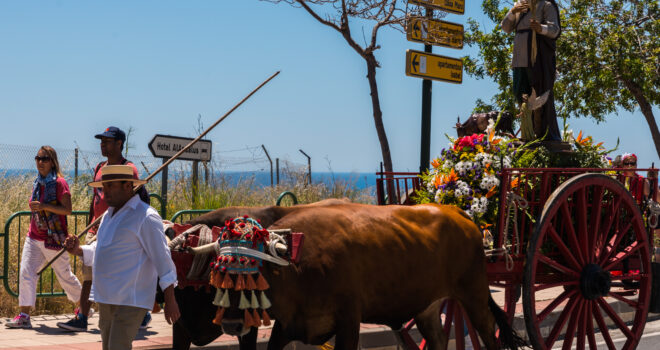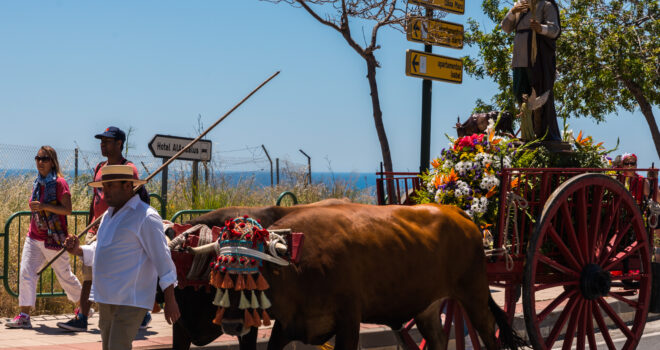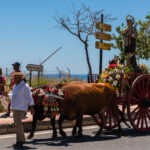Anyone who has farmed can tell stories about the heartbreaks of weather problems, crop failures, and labor shortages. But there also the good tales: stretches of just-right temperatures and rain, bumper crops, and fondly-remembered projects when many hands joined in success. Holy Scripture is replete with depictions of farming and agricultural metaphors. And yet, very few saints are identified primarily as farmers. Isidore, a twelfth century Spaniard, is one of those few.
St. Isidore the Farmer (or “the Laborer,” as he is sometimes known) has left few details of his earthly life. He was born in 1070 and died in 1130. He was married and his son died in childhood. He worked for a rich landowner, was devoted to the Mass and prayer, and gave generously to the poor. Although he was known for his piety and even some miraculous happenings, he lived the life of one of God’s “least.” After death his sanctity was gradually revealed and he gained a reputation for intercession and miracles. When Isidore was canonized in 1622, he was once again “the least,” being the most obscure among the five new saints, which included Teresa of Avila, Philip Neri, Francis Xavier, and Ignatius of Loyola.
We remember Isidore on May 15 (a memorial on the 1969 calendar); he is also commemorated with a third class feast on October 25 on the 1962 calendar. The two dates are fitting bookends for a farmer’s life. In the northern hemisphere May is typically a month of planting, while October is a time of harvest. Those two months also share a Marian orientation. May has long been dedicated to the Blessed Virgin, while in October we remember in a special way Our Lady’s Holy Rosary.
What can this obscure saint teach us today in an age of global supply chains and imported food? He left no printed theology books or even sayings. To many in our culture the regular routines of farm work are known only through the pages of the Little House books or the surprisingly large number of romance novels about Amish life. But those with ears to hear and a receptive heart will receive a valuable theological message. St. Isidore’s life illustrates the fact that a little humility goes a long way. That message is doubly fitting because “humility” derives from the Latin “humus,” meaning soil. The 1962 collect prayer for St. Isidore’s feast reads in part: “Grant us, we pray Thee, merciful God, by the intercession of Thy blessed confessor Isidore, the farmer, to overcome any feelings of pride; and by his merits and example to serve Thee with that humility in which Thou takest pleasure.”
St. Isidore also reminds us that everyday life can be the arena for our sanctification. He was devout and pious, making prayer and Mass and almsgiving priorities, while not neglecting his state in life as a married man and a worker under authority. Catholics can sometimes neglect or overlook the small aspects of life as means of sanctification. Thankfully, a later saint, Therese of Lisieux, taught us about the heavenly value of the “little way” here in this world, endorsing, as it were, Isidore’s life on the farm.
The Church has named St. Isidore the farmer as patron of farmers and rural laborers, while also serving paradoxically as patron of the urban metropolis of Madrid because he worked on the outskirts of that city during medieval times and frequently visited its churches. In 1947 he was proclaimed the heavenly patron of the U.S. National Catholic Rural Life Conference. That church-endorsed non-profit, now in its one-hundredth year, is dedicated to “promoting Catholic life in rural America.” St. Isidore is also revered by proponents of the Catholic Land Movement (CLM), led by lay Catholics living out and advocating for a return to homesteading and traditional skills. Today St. Isidore is a common name for the farmsteads of dedicated Catholics.
The modern apostle of the CLM was a Catholic priest, Fr. Vincent McNabb, who in the early twentieth century articulated a vision of Catholics leaving corrupting city existence for the spiritually and physically healthier rural life, in which Christ-centered families would learn and share skills in order to gain a measure of self-sufficiency. McNabb worked primarily in England and his ideas did not bear immediate fruit, but his influence continues today, especially in the CLM. In the U.S. the co-founders of the Catholic Worker (CW) paper and movement, Peter Maurin and Dorothy Day, also spoke about the need for farms as remedies for social ills. A number of CW farm projects were named after St. Isidore.
Cities have always needed farms to supply food, and archaeologists and historians tell us that cities were not even possible before sustainable large-scale agriculture was established. But as necessary as the food for our bodily sustenance is, our “supersubstantial” bread—the Holy Eucharist—is even more important. In St. Isidore the Farmer, we have a saint who showed us how to cultivate both our earthly and heavenly food.













